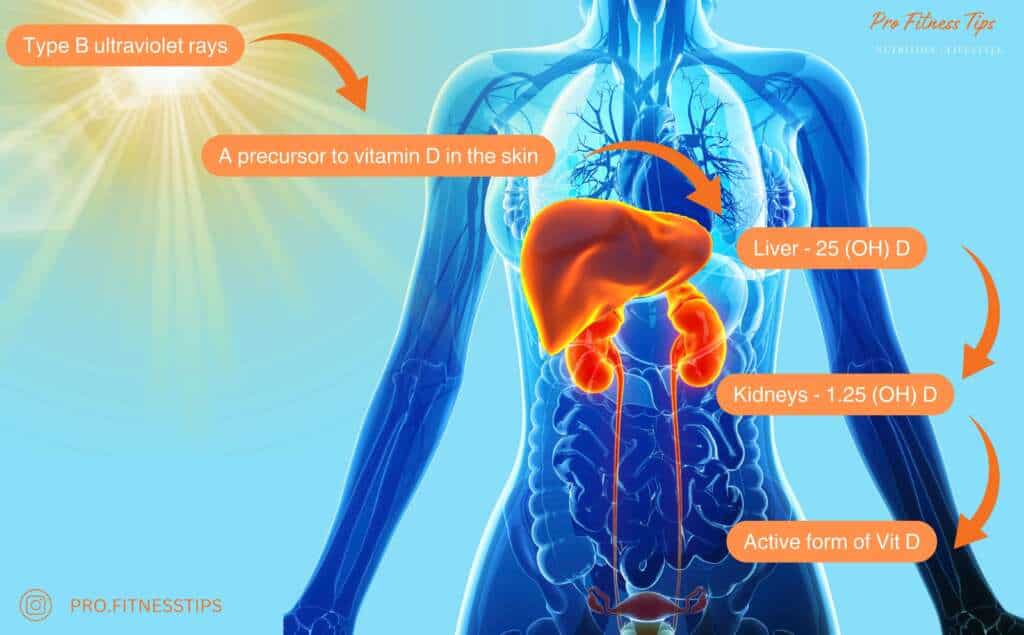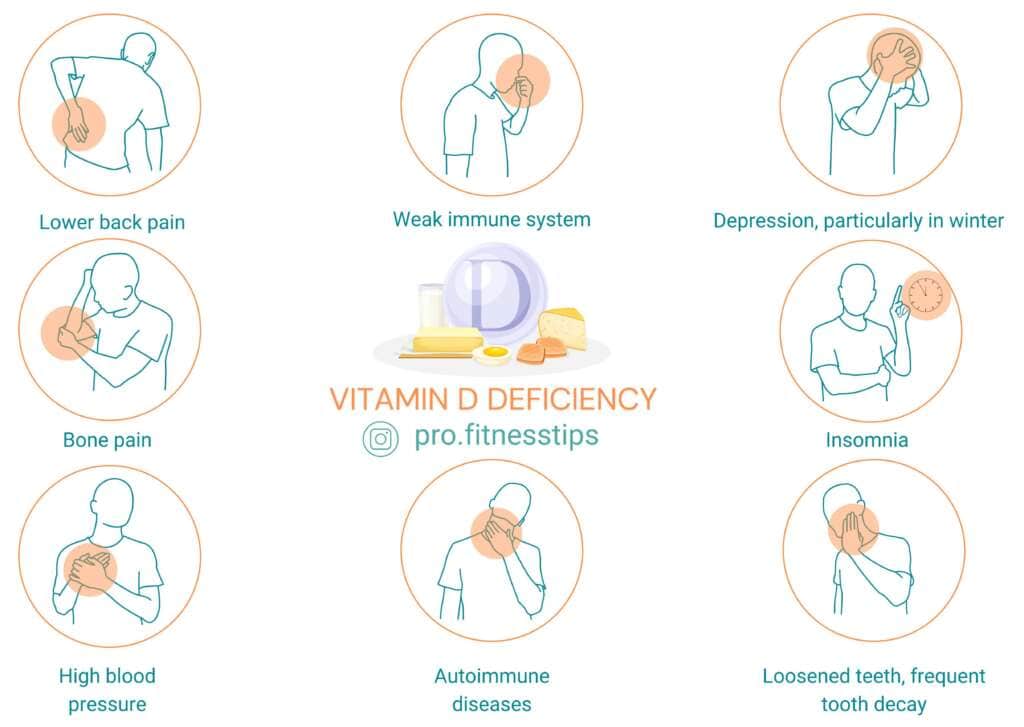Vitamin D – All You Need To Know
Vitamin D is perhaps the most researched nutrient these days. It used to be that the main purpose of Vitamin D was to fight rickets, as it helps the body absorb and retain the calcium and phosphorus needed to build bones. But in the modern world, there has been research showing that many organs have receptors for Vitamin D, and that is why it is under the scrutiny of scientists.
Main Characteristics of Vitamin D
Let’s start with the fact that Vitamin D is not technically a vitamin. Although it is firmly established as one of the four fat-soluble vitamins, it acts more like a hormone. It violates all the rules that apply to vitamins – it is produced in the human body, is found in very limited amounts in natural foods, and when taken with food, must be converted by the body before it can work to its benefit.
Since Vitamin D is extremely hard to get from food, our bodies are designed to get it from the sun. Sunlight hitting the skin converts the universal form of cholesterol (7-dehydrocholesterol) into Vitamin D3. But in order for the vitamin to begin to benefit our bodies, it must work its way through the liver and kidneys to become the active form of vitamin D.

In the liver, vitamin D is converted to 25(OH)D, which is the substance doctors usually measure to diagnose vitamin D deficiency. It then travels to the kidney, where it becomes 1.25(OH)2D -calcitriol – the active form of vitamin D.
Although much research is still in progress, the main properties of Vitamin D can be emphasized:
1. Calcium metabolism. Vitamin D promotes calcium absorption in the intestine and helps maintain adequate levels of calcium and phosphorus in the blood.
2. Cardiovascular system. Vitamin D regulates immune and inflammatory cells involved in the development of cardiovascular disease and helps keep arteries flexible, which helps control high blood pressure.
Health Professionals Follow-up Study conducted a 10-year study involving 50,000 healthy men. Men with severe vitamin D deficiency were twice as likely to have a heart attack as those with high vitamin D levels.
3. Immune system. The role of Vitamin D in the regulation of the immune system has been identified after many studies that have been conducted in different areas: multiple sclerosis, type 1 diabetes, influenza, tuberculosis, autoimmune diseases, and even the effect of Vitamin D on the COVID-19 coranavirus. The results of many of these studies have shown how important Vitamin D is to our immunity. Many studies are still ongoing, but it is already clear that Vitamin D is in its own way an immunomodulator that helps dampen inflammation.
4. Cancer. Some ongoing research suggests that Vitamin D may play an important role in longevity in cancer patients. And, while years of research are still needed to confirm one theory or another, a meta-analysis of randomized trials of vitamin D has already found a statistically significant 13% reduction in the risk of cancer mortality among those who took vitamin D compared to placebo.
5. Cognitive impairment. In an analysis of over 427,000 white Europeans, the risk of dementia was found to be 54% higher among participants with low blood levels of vitamin D <25 nmol/L compared to those with sufficient levels of 50 nmol/L.
*Although I know and read recent studies that try to deny these properties of Vitamin D, I am still absolutely convinced that the role of Vitamin D in our body is huge.
Symptoms of Vitamin D Deficiency

Causes of Vitamin D Deficiency
1. Insufficient intake with food.
2. Insufficient exposure to the sun and factors such as:
a. Your place of residence. The closer you live to the equator, the easier it is for your body to synthesize vit D when exposed to sunlight throughout the year. The farther you are from the equator, the less vitamin D is produced in your skin.
b. If most of your body is covered by clothing (may be because of religion).
c. If, when you leave the house, you apply SPF cream.
d. Rarely go outside, spending most of your time at home, office, etc.
e. Environment. Cloudiness and high levels of air pollution in metropolitan areas negatively affect vit D synthesis in the skin
3. Skin color. The pigment melanin, which is more common in people with darker skin, reduces the body’s ability to produce vit D in response to sunlight exposure. The good news for people with pale skin is that you produce vit D faster than people with darker skin.
4. Age. As we age, our skin also ages and does less and less well at converting sunlight into vit D.
5. Overweight. People who are overweight and consequently have an excess fat layer have a greater difficulty synthesizing vit D.
6. Love of sweets. Yes, you don’t have to reread this one! That’s right – high consumption of sugar, especially fructose, increases the production of an insidious enzyme that destroys vit D stores.
7. GI Disease. Intestinal diseases can cause difficulty digesting dietary fats, which increases the risk of developing vit D deficiency. This risk group includes people with Crohn’s disease, untreated celiac disease, pancreatic enzyme deficiency, and those who have had parts of their intestines removed.
Vitamin D Excess
About 1 billion people worldwide are vitamin D deficient, and 50% of the population has vitamin D insufficiency. Vitamin D intoxication is extremely rare. Intoxication from sun exposure is not impossible because the skin breaks down excess of the vitamin. The only way a person can get toxicity is through long-term use of extremely high doses of vitamin D.
Some symptoms associated with excess vitamin D include:
- hypercalcemia
- nausea
- apathy
- vomiting
- abdominal pain
- dehydration
- confusion
- increased thirst
Top Foods Rich With Vitamin D
- Fish oil
- Cod liver
- Salmon, sardines and other fatty fish
- Beef liver
- Egg yolk
- Dairy products (including Vitamin D-enriched milk, yogurt, cheese)
- Mushrooms
Should I Take Vitamin D Supplements?
Even if you eat foods rich in vitamin D, it is unlikely that you will get all the vitamin D you need from food. Most vitamin D is produced through the skin when we are outside in daylight.
The most active synthesis of vitamin D in the skin occurs when sunlight hits exposed skin at right angles, which means between 11 and 15. But during this time we try to avoid direct sunlight and use sunscreen, which
block the production of vitamin D.
Also, if you are rarely outside, in your country of residence the seasons change (there is winter), fresh sea fish is unavailable, then it is worth thinking about taking Vitamin D in the form of supplements.
First of all, it is necessary to take tests to understand whether you need to raise the level of vitamin D – 25(OH)D. If you have a deficiency, which is only shown by blood tests, your doctor should prescribe the dosages to raise your vitamin D levels, as high doses of vitamin D can be dangerous if you prescribe them yourself!
The approximate reference values of the 25(OH)D vitamin D blood test are shown in the table below*:
nmol/L | ng/mL | Health Conditions |
<30 | <12 | Deficiency, which can lead to rickets in infants and children and osteomalacia in adults |
30 to <50 | 12 to <20 | Generally considered insufficient for bone and whole body health in healthy individuals |
≥50 | ≥20 | Generally considered adequate for bone and whole body health in healthy individuals |
>125 | >50 | Already considered excess vitamin D and may lead to adverse effects |
*This table is for informational purposes only and may not be used for any medical purposes
You should consult your physician or other health care professional before using any vitamins, supplements, or research chemicals.
- By Yelena B
- No Comments




Leave a reply